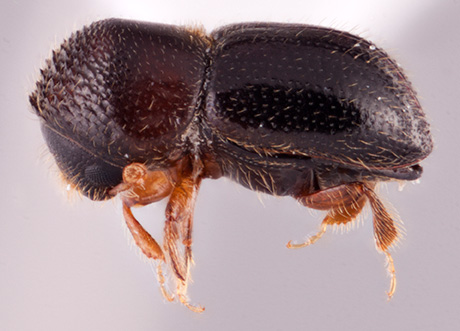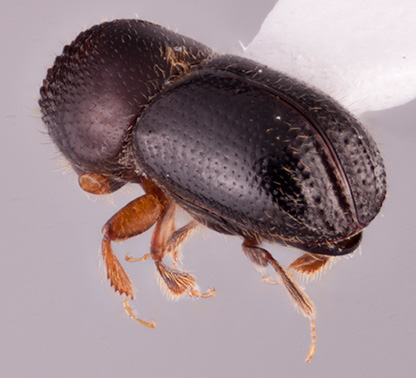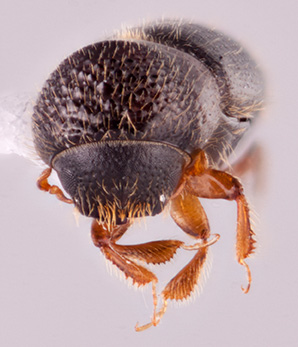Anisandrus maiche
|
Anisandrus maiche lateral; R.K. Osborn |
|
Anisandrus maiche dorsal; R.K. Osborn |
|
Anisandrus maiche declivity; R.K. Osborn |
|
Anisandrus maiche frontal; R.K. Osborn |
Taxonomic history
Xyleborus maiche Kurentzov, 1941: 192.
Anisandrus maiche (Kurentzov): Nikulina et al. 2015: 43.
Synonyms
Xyleborus maiche Eggers, 1942: 36. Homonym. Synonymy: Pfeffer 1944: 131.
Diagnosis
2.2−2.5 mm long (mean = 2.3 mm; n = 5); 2.3−2.78 times as long as wide. This species can be distinguished by the mesonotal mycangial tuftmycangial tuft:
tuft of setae that denotes the mycangia exterior opening
 the length of the scutellumscutellum:
the length of the scutellumscutellum:
a shield-like sclerotized plate located at the midpoint of the elytral base
; declivitaldeclivital:
pertaining to the elytral declivity
interstriae 1−4 uniseriately denticulatedenticulate:
covered in denticles
; discaldiscal:
pertaining to the disc of either the pronotum or elytra
interstriae punctures uniseriate; declivitydeclivity:
downward slope of either the pronotum or elytra
 appearing bisulcatebisulcate:
appearing bisulcatebisulcate:
pertaining to an elytral declivity with two suci; a sulcus present on each elytron but the suture remains convex
with impressedimpressed:
a depression in a surface
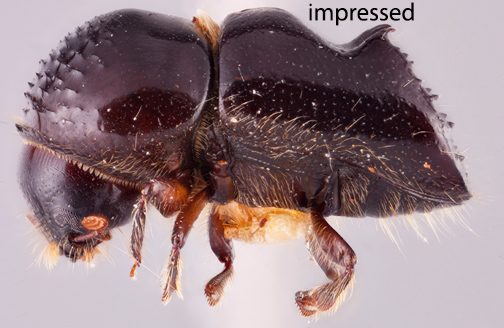 from striaestria:
from striaestria:
punctures in rows, which may or may not be impressed to make grooves 1 to interstriaeinterstria:
1 to interstriaeinterstria:
longitudinal spaces along the elytra between the striae, which is not as<br />
impressed and bear smaller punctures.
 2, interstriaeinterstria:
2, interstriaeinterstria:
longitudinal spaces along the elytra between the striae, which is not as<br />
impressed and bear smaller punctures.
 3 distinctly raised; declivitaldeclivital:
3 distinctly raised; declivitaldeclivital:
pertaining to the elytral declivity
punctures small, uniseriate; shiningshining:
appearing glossy or bright in luster; referring to a surface that is polished and reflects light well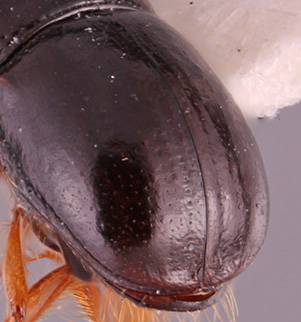 appearance; and small body size.
appearance; and small body size.
May be confused with
Anisandrus dispar, A. paragogus, Xylosandrus dentipennis, X. eupatorii, X. germanus, and X. metagermanus
Distribution
China (Heilongjiang, Shanghai), Japan, South & North Korea, Russia (European (introduced), Far East), Italy, Ukraine (Colombari et al. 2022Colombari et al. 2022:
Colombari F, Martinez-Santilde;udo I, Battisti A. 2022. First report of the alien ambrosia beetle Cnestus mutilatus and further finding of Anisandrus maiche in the European part of the EPPO region (Coleoptera: Curculionidae: Scolytinae: Xyleborini) EPPO Bulletin, 00, 1-5. Available from: https://doi.org/10.1111/epp.12840). Introduced to USA (Rabaglia et al. 2009Rabaglia et al. 2009:
Rabaglia RJ, Vandenburg N, Acciavatti RE. 2009. First records of Anisandrus maiche Stark (Coleoptera: Curculionidae: Scolytinae) from North America. Zootaxa 2137: 23-28. https://doi.org/10.11646/zootaxa.2137.1.2; Gomez et al. 2018aGomez et al. 2018a:
Gomez DF, Rabaglia RJ, Fairbanks KEO, Hulcr J. 2018a. North American Xyleborini north of Mexico: a review and key to genera and species (Coleoptera, Curculionidae, Scolytinae). ZooKeys 768: 19-68. https://doi.org/10.3897/zookeys.768.24697) and Canada (Ontario, Quebec) (Thurston et al. 2022Thurston et al. 2022:
Thurston GS, Slater A, Nei I, Roberts J, McLachlan Hamilton K, Sweeney JD, Kimoto T. 2022. New Canadian and provincial records of Coleoptera resulting from annual Canadian Food Inspection Agency surveillance for detection of non-native, potentially invasive forest insects. Insects 13: 708. https://doi.org/10.3390/insects13080708).
Host plants
polyphagous, recorded from eight families of trees (Rabaglia et al. 2009)
Remarks
Kurentzov (1941) and Terekhova and Skrylnik (2012) provide information on the biology and gallery system, which are similar to A. dispar.
DNA data
Sequences available for COI and CAD.

